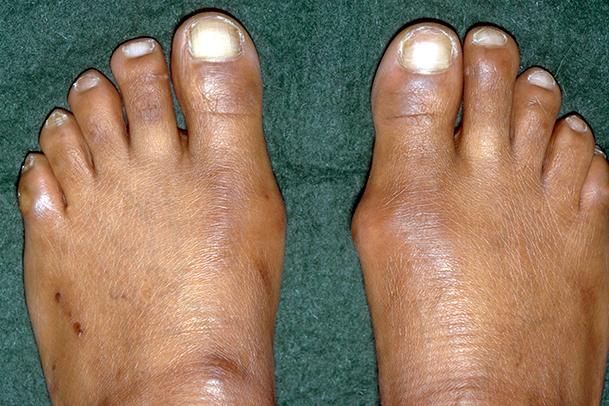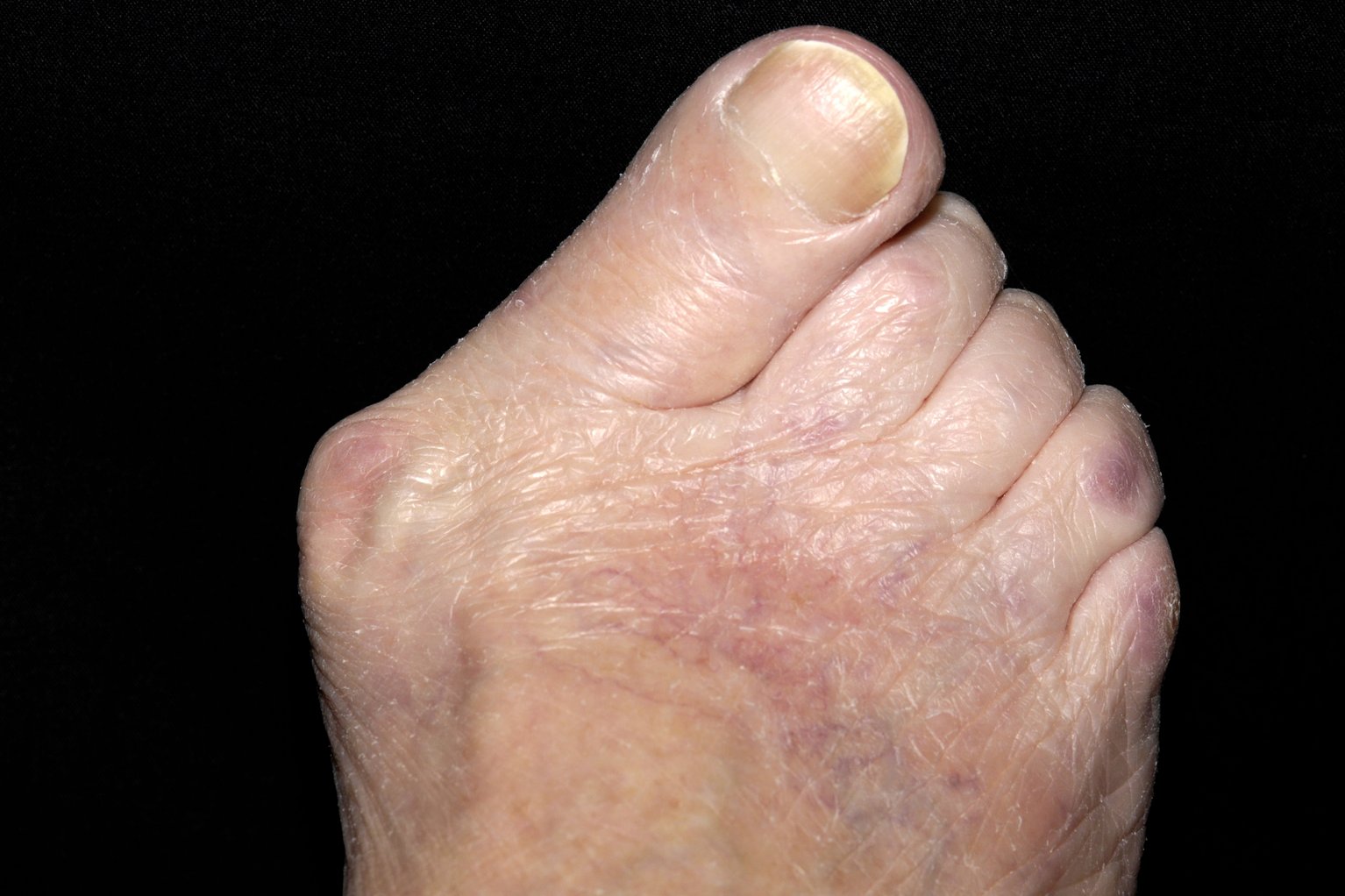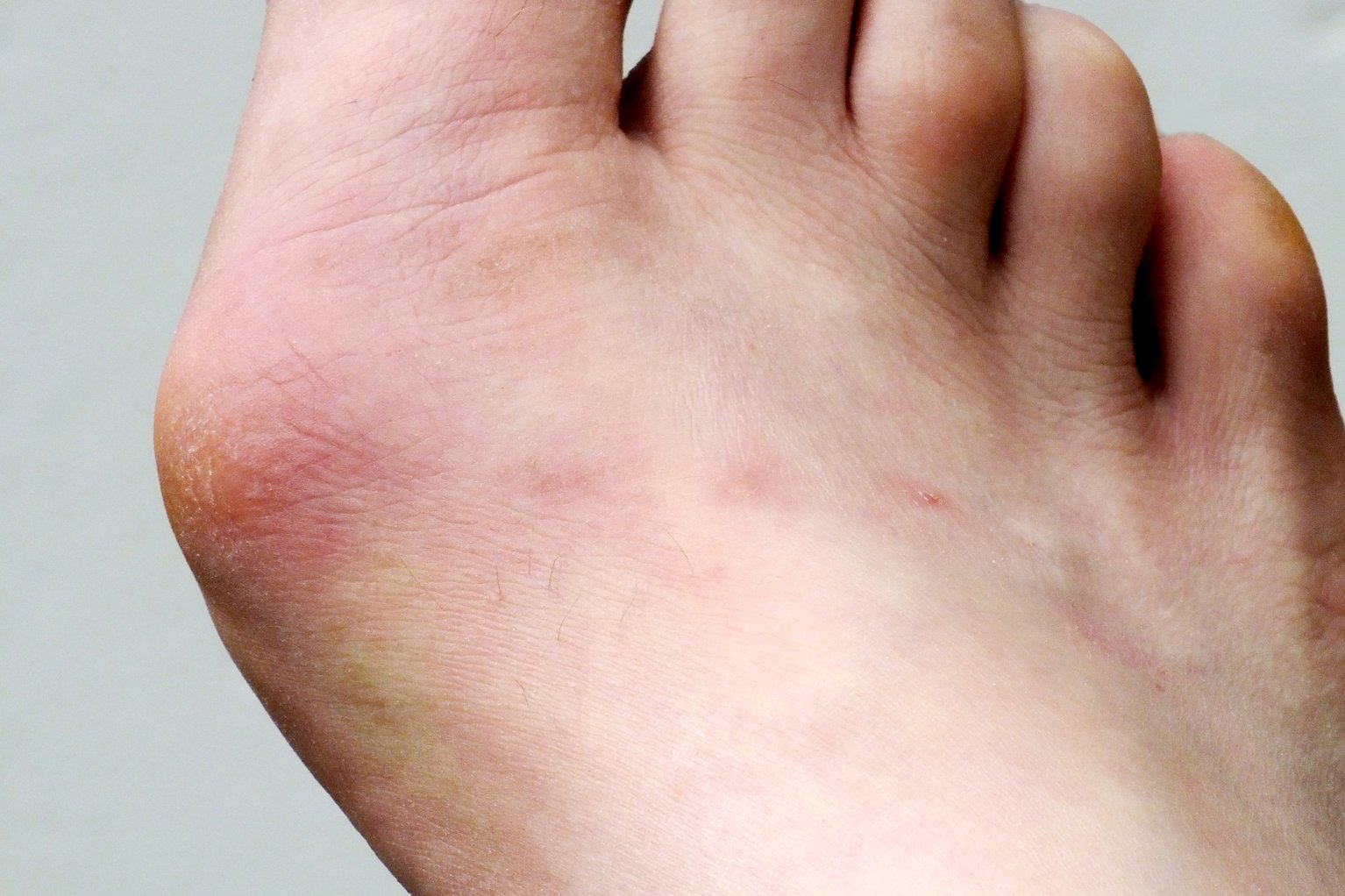Patient Information

Bunions
What is a bunion?
A bunion is a deformity of the big toe. The big toe moves towards the other toes (this bending over is called hallux valgus) leading to a prominence (the bunion) on the inner side of the big toe joint and a wider foot.
What are the symptoms?
- Pain, swelling and redness are common symptoms. These tend to be worse when walking.
- The big toe can rub against the other toes, sometimes sitting on top or under the other toes.
- Problems with fitting your foot into certain shoes due to the prominence and the width of the foot.

Hard lumps on the sides of your feet, by your big toes.

Your big toe pointing towards your other toes.

Hard or swollen skin. The bunion may look red or darker than the surrounding skin.
What can cause the condition?
The causes vary but can include:
- Poorly fitting or tight shoes.
- A possible hereditary link (they often run in families).
- Inflammatory arthritic conditions (such as rheumatoid arthritis).
- Certain neurological conditions and muscle imbalances in the foot.
How can bunions be treated?
There are a number of non-operative treatments, including:
Footwear
Wide-fitting, low-heeled, extra-depth shoes with soft uppers will allow for the extra width of the foot, any under-riding or over-riding of the big toe and the prominence. This will reduce the pressure over these areas. Running trainers are also an excellent option. You must avoid tight fitting or high-heeled shoes.
Insoles (orthoses)
If your bunion is associated with a flat foot or some degenerative changes in the big toe joint (pain and stiffening of the joint), insoles (also known as orthoses) may be recommended. These will fit in to shoes with a wide, deep toe box area or running trainers.
Toe splints / Bunion protectors
Toe splints and spacers may help to reduce any rubbing in between the big toe and the other toes. Padding over or around the bunion may also be helpful providing you have wide shoes or running trainers.
Weight
Try to manage your weight as being overweight is likely to increase your foot pain. Pain medication - If you experience pain, then some simple pain medication may help. If you are unsure what to take then this can be discussed with your Foot & Ankle Specialist, local pharmacist or GP.
Injections
A corticosteroid (steroid) injection may be suggested alongside some of the above treatments. This helps reduce inflammation and may be helpful if you have pain and stiffness in the joint due to arthritis.
Surgery
If you have very little or no relief from these non-surgical treatments, your Foot & Ankle Practitioner may suggest you consider surgery if you are fit and well enough.
Surgery may involve cutting the bones and re-positioning them (known as osteotomies) or fusing the big toe (i.e. stiffening the big toe joint). You will normally need to be in a surgical shoe for about 6-8 weeks after such procedures.
What is a metatarsal osteotomy?
A metatarsal osteotomy is an operation for bunions. The exact type of osteotomy can vary and may be known as a ‘Scarf’ or ‘Chevron’ osteotomy, but the principles of the operation are the same. Often an ‘Akin’ osteotomy is also performed to help realign the toe.
Why might this surgery be necessary?
Surgery for a bunion may be advised if simple measures, such as well-fitting shoes, simple painkillers and padding do not relieve the discomfort of the bunion. It may also be performed if the big toe is so deformed that it is pressing on or overlapping the second toe. It is only appropriate if you are willing to be realistic about footwear after surgery and understand and accept the potential problems of the procedure.
What does the operation involve?
A cut is made on the side of the bunion. The big toe joint is opened and the bony lump is removed. The first metatarsal is cut through, repositioned and fixed with one or two screws. Sometimes a second cut is made between the first and second toes to free up the tight tissues on this side of the toe. The soft tissues on the other side of the joint are tightened to correct the deformity and the wound stitched up. The foot is dressed in soft bandages.
The expected outcome of this surgery is:
- Deformity correction
- Improved function of the big toe
- Improved pain relief, with decreased analgesic requirements
Can it be done as a day case operation?
If you are medically fit, have someone who can collect and look after you following the operation, and you are comfortable afterwards, the operation can be done on a day case basis. If you have other medical problems such as diabetes, asthma or high blood pressure, you may have to attend the pre-operative assessment clinic 2-6 weeks before your surgery. You may need to stay in overnight after your surgery. If you cannot be collected and looked after, you must stay overnight to avoid complications. The commonest reason for having to stay overnight after bunion surgery is for pain control as many of these operations involve breaking and re-positioning a bone. They may be quite painful immediately afterwards. Local anaesthetic injections can help with this, but not everyone is comfortable to go home.
Will I have to go to sleep (general anaesthetic)?
The operation can be done under general anaesthetic (asleep). Alternatively, an injection in the back, leg or around the ankle can be done to make the foot numb while the patient remains awake. Local anaesthetic injections do not always work. In that case, you may have to go to sleep for the operation. Your anaesthetist will advise about the best choice of anaesthetic for you. In addition, local anaesthetic may be injected into your leg or foot while you are asleep to reduce the pain after the operation even if you go to sleep for the surgery. You will also be given painkilling tablets as required. The physiotherapist will show you how to walk with crutches. We will get you up as soon as possible!
Will I have a plaster on afterwards?
You do not usually need a plaster after a metatarsal osteotomy. We will put dressings and a bandage on your foot, and you can walk, putting your weight through the heel in a protective sandal with a stiff sole (post-op shoe).
What will happen afterwards?
You can go home when comfortable and safe. For the first 2 weeks, you should avoid walking if possible and only put your weight through the heel. When not walking, rest with your foot elevated, ideally at the level of your heart. You should gently move your ankle and foot. This will reduce swelling and therefore aid the healing process and will be more comfortable for you. You will usually be seen in the nurse-led clinic 2-3 weeks after your operation. The dressings will be removed, the wound examined and the stitches removed if necessary. You will then often have a splint put on your toe to help hold it in position. You should wear the splint both in the day and night. You will then be more mobile and able to walk on your heel (using the post-op shoe) using crutches to support you if needed. You will be able to remove the splint for bathing and showering once the wound is well healed. Usually, another clinic appointment will be made for about 4 weeks later. At this time, the splint will be removed, the toe examined, and another x-ray taken. It is advised to continue to wear the splint at night for another 6 weeks.
When can I...
Go back to work
This depends on what you do and how you get to work. If you have a sitting down job that you could do with your foot elevated and you can get a lift to work, you could probably go back to work a few weeks after surgery, once the wounds are healed. On the other hand, if you have a heavy manual job you may be away from work for up to 3 months. If you need to drive to work, this will affect when you can go back. A member of the foot and ankle team will advise you about going back to work.
Drive
Once your splint has been removed you may be able to start driving again. You must be comfortable and not too stiff before trying to drive. Start by sitting in the car and trying the pedals. Then drive round the block. Drive short distances before long ones. If you cannot safely make an emergency stop, your insurance will not cover you in the event of an accident. You must be able to control the car at all times. Please ask a member of the foot and ankle team when it is safe for you to drive again.
Play sport
After your splint has been removed, you can start gently exercising your foot and walking further each day. When you are comfortable doing this, you can start gentle running and stretching. Contact, twisting and impact sports can follow as comfort dictates. Everyone varies as to how quickly they can take up exercise again. Be guided by your own body’s reactions and the advice of your surgeon. Most people can get back to most of their previous activities within 6 months of bunion surgery.
The risks
Research shows that 85 out of 100 people who have bunion corrections are satisfied with the results. However, a number of problems can arise. The following list may appear to be a lot of possible problems, but in fact, most people do not get them and are satisfied with their bunion surgery.
COVID-19
COVID-19 infection increases the risk of complications and we recommend you read the separate leaflet about this. If you are in one of the vulnerable groups you should think very carefully about proceeding with surgery unless it is absolutely necessary
Chronic regional pain syndrome (CRPS)
The main symptom of chronic regional pain syndrome (CRPS) is pain, which can sometimes be severe, continuous and debilitating. It's usually confined to one limb, but can sometimes spread to other parts of the body.
Slightly stiffer big toe
The big toe is usually stiffer than before. For most people this does not matter, but for athletes or dancers it is very important.
Slightly weaker big toe
The big toe is slightly weaker with a bunion, and this transfers weight onto the ball of the foot. After bunion surgery, this transfer of weight can increase. Therefore, if you have pain under the ball of the foot (“metatarsalgia”) it may be worse after bunion surgery and it may also develop for the first time. Careful surgical technique can reduce this risk, but it cannot avoid it completely. Most people who develop metatarsalgia are comfortable with a simple insole in the shoe but occasionally surgery is required.
Tilting big toe
In some people, the big toe slowly tilts back toward the original position and occasionally this is bad enough to need to have the operation redone. On the other hand, the toe can tilt the other way, though much more rarely. Again, occasionally, this is bad enough to need to have the operation redone.
Infections
Infections in the wound and minor damage to the nerves of the toe can occur in any foot surgery. Usually, these are minor problems that get better quickly.
Chronic Regional Pain Syndrome (CRPS)
Some patients can develop CRPS, a chronic pain condition that can be hard to treat.
Swelling
The foot tends to swell up quite a lot after surgery. Swelling is part of your body’s natural response to any injury and surgery is no exception. In addition, your foot is at the bottom of your body so fluid tends to collect in its tissues and cause swelling. People vary in how quickly this swelling disappears after an operation and 6 months is not unusual. If you are not having undue pain or inflammation there is probably nothing to worry about and you can afford to give it time.
Deep vein thrombosis and Pulmonary Embolus
Blood clots in your legs or lungs
What can I do to help reduce risks?
Most patients find that simple measures can make a big difference to the outcome of surgery. The evidence from studies and our experience supports this:
- Take simple Vitamin C and vitamin D tablets for healing
- Stop smoking, smoking slows down healing and is linked to increased complications
- Keep fit and a healthy weight, many foot problems are improved by losing weight
Further information about risks
The figures for complications given in this leaflet have been taken from information produced by the British Orthopaedic Foot and Ankle Society using audits from all areas of the UK.